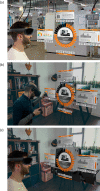Workforce and supply chain disruption as a digital and technological innovation opportunity for resilient manufacturing systems in the COVID-19 pandemic
- PMID: 35431410
- PMCID: PMC8993411
- DOI: 10.1016/j.cie.2022.108158
Workforce and supply chain disruption as a digital and technological innovation opportunity for resilient manufacturing systems in the COVID-19 pandemic
Abstract
During the SARS-CoV-2 pandemic (also known as COVID-19), workforce downsizing needs, safety requirements, supply chain breaks and inventory shortages affected manufacturing systems' and supply chain's responsiveness and resilience. Companies wandered in a disrupted scenario because recommended actions/strategies to survive - and thrive - were not available an improvised actions to keep their operations up and running. This paper analyzes the COVID-19 impacts on the workforce and supply resilience in a holistic manner. The following research questions are discussed: (i) how can manufacturing firms cope with urgent staff deficiencies while sustaining at the same time a healthy and safe workforce in the perspective of socially sustainable and human-centric cyber-physical production systems?; (ii) is remote working (cf. smart working) applicable to shop-floor workers?; (iii) is it possible to overcome supply chain breaks without stopping production? In the first part, we propose three Industry 4.0-driven solutions that would increase the workforce resilience, namely: (i) the Plug-and-Play worker; (ii) the Remote Operator 4.0; (iii) the Predictive Health of the Operational Staff. In the second part, the concepts of (i) Digital & Unconventional Sourcing, i.e. Additive Manufacturing, and (ii) Product/Process Innovation are investigated from a novel business continuity and integration perspective. We ultimately argue that forward-looking manufacturing companies should turn a disruptive event like a pandemic in an opportunity for digital and technological innovation of the workplace inspired by the principles of harmonic digital innovation (that places the human well-being at the center). These aspects are discussed with use cases, system prototypes and results from research projects carried out by the authors and real-world examples arising lessons learned and insights useful for scientists, researchers and managers.
Keywords: Additive manufacturing; COVID-19 pandemic; Digitalization; Industry 4.0; Manufacturing systems; Operator 4.0; Resilience; Supply chain disruption.
© 2022 Elsevier Ltd. All rights reserved.
Conflict of interest statement
The authors declare that they have no known competing financial interests or personal relationships that could have appeared to influence the work reported in this paper.
Figures












References
-
- Achillas C., Tzetzis D., Raimondo M.O. Alternative production strategies based on the comparison of additive and traditional manufacturing technologies. International Journal of Production Research. 2017 doi: 10.1080/00207543.2017.1282645. - DOI
-
- Ansari F., Khobreh M., Seidenberg U., Sihn W. A problem-solving ontology for human-centered cyber physical production systems. CIRP Journal of Manufacturing Science and Technology. 2018;22:91–106.
-
- Atzeni E., Salmi A. Economics of additive manufacturing for end-usable metal parts. The International Journal of Advanced Manufacturing Technology. 2012;62(9–12):1147–1155.
-
- BBC (2020). Covid-19: World's top latex glove maker shuts factories. Accessed on: January 15th, 2021. Retrieved from: https://www.bbc.com/news/world-asia-55053846.
-
- Bottani E., Murino T., Schiavo M., Akkerman R. Resilient food supply chain design: Modelling framework and metaheuristic solution approach. Computers & Industrial Engineering. 2019;135:177–198.
LinkOut - more resources
Full Text Sources
Miscellaneous
